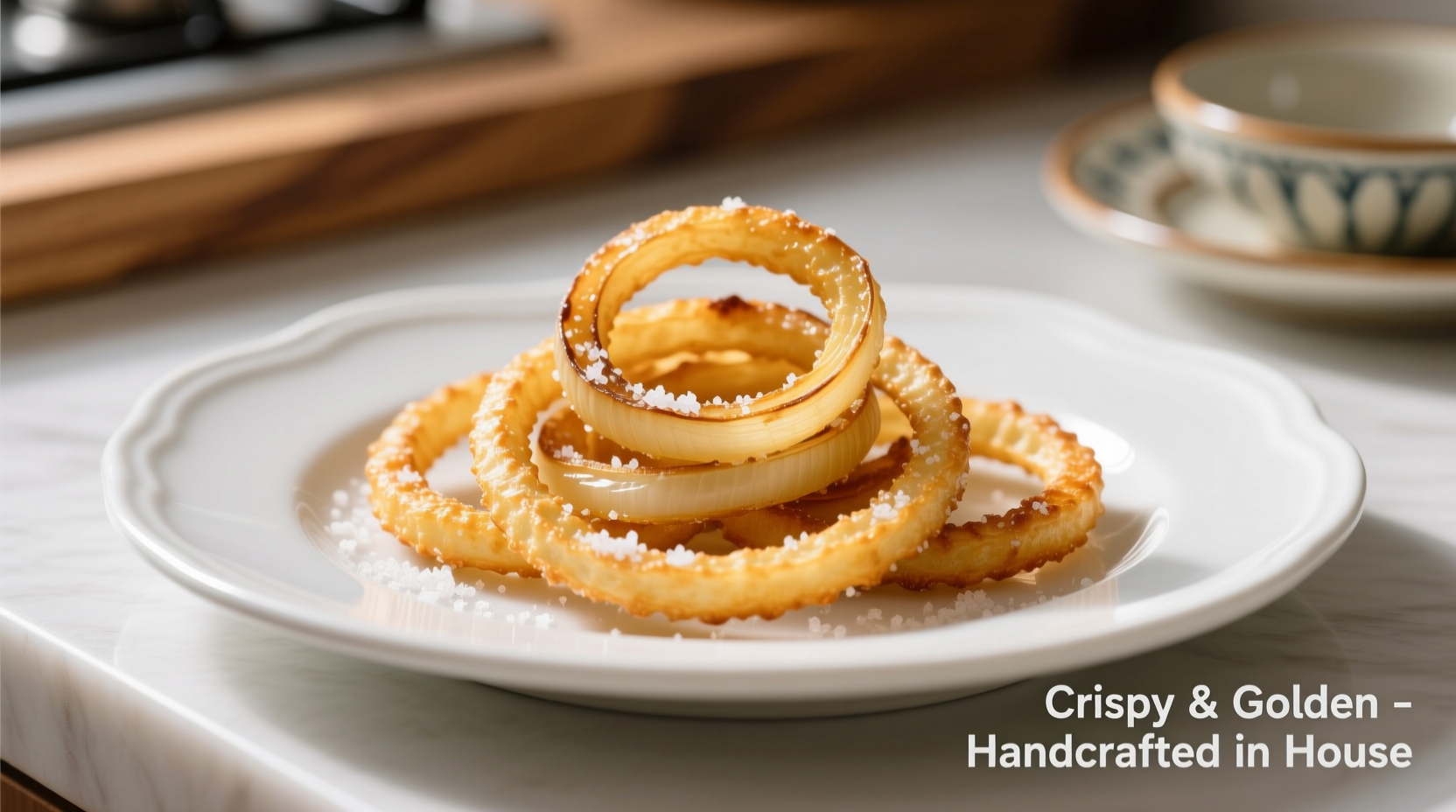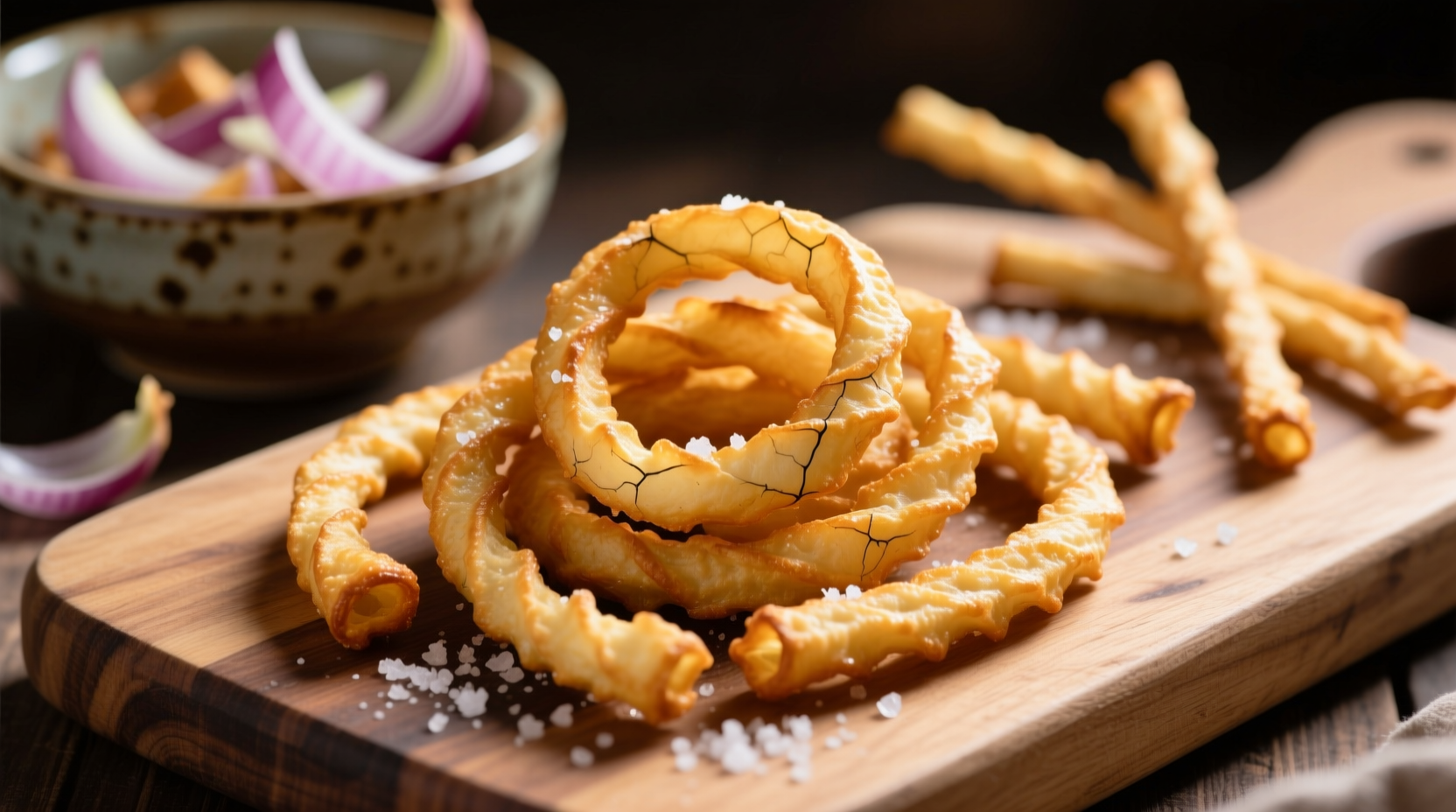What Exactly Are Crispy Onion Straws?
While often confused with onion rings, crispy onion straws represent a distinct preparation method. These delicate strands measure approximately 1/8-inch thick and maintain uniform dimensions throughout their length, creating consistent cooking results impossible with irregularly shaped rings. Food science research from the USDA Agricultural Research Service confirms that uniform thickness directly impacts moisture evaporation rates during frying, which is critical for achieving that signature shatter-crisp texture.

The Science Behind Perfect Crispiness
Professional chefs understand that onion straws' superior crunch comes from precise moisture management. When onions hit hot oil (ideally between 350-375°F), the rapid temperature change causes immediate water evaporation from the surface while creating a protective barrier that prevents oil absorption. Cornell University's Food Science Department notes that the Maillard reaction begins at 285°F, creating complex flavor compounds while the starches in properly formulated batter undergo gelatinization, forming that essential crisp shell.
Homemade vs. Commercial Onion Straws: Key Differences
| Characteristic | Homemade Onion Straws | Commercial Products |
|---|---|---|
| Thickness Control | Requires mandoline for consistency | Precision-cut by machinery |
| Batter Composition | Freshly mixed, no preservatives | Contains stabilizers and anti-caking agents |
| Oil Absorption | 15-18% when properly fried | 20-25% due to industrial processing |
| Shelf Life | 2-3 hours at peak crispness | 6-12 months with packaging |
Step-by-Step Guide to Perfect Homemade Onion Straws
Follow this professional chef-tested method for restaurant-quality results:
- Preparation: Chill onions for 30 minutes before slicing—this reduces moisture content and makes cutting easier. Use a mandoline set to 1/8-inch thickness for uniform strands.
- Drying Process: Spread cut onions on paper towels and refrigerate uncovered for 20 minutes. This critical step removes surface moisture that would cause splattering and prevent crispiness.
- Batter Formulation: Combine 1 cup rice flour, 1/2 cup cornstarch, 1 tsp baking powder, and 1/4 tsp xanthan gum. Whisk in 1 cup ice-cold sparkling water just before use—the carbonation creates additional lift during frying.
- Frying Technique: Heat neutral oil to 365°F in a deep fryer or heavy pot. Fry in small batches for 90-120 seconds until golden. Drain immediately on wire racks, not paper towels, to maintain crisp texture.
Serving Suggestions That Impress
Chefs at the Culinary Institute of America recommend these professional applications:
- Garnish Upgrade: Sprinkle over creamy soups or salads for textural contrast
- Burger Enhancement: Layer between patty and bun instead of traditional rings
- Cocktail Accompaniment: Serve alongside bloody marys or micheladas
- Dipper Alternative: Use in place of chips for onion dip or pimento cheese
Storage Secrets for Maximum Freshness
While best served immediately, food safety guidelines from the FDA Food Code indicate proper storage can extend shelf life. Cool completely on wire racks, then store in airtight containers with silica gel packets. For longer storage, freeze in single layers before transferring to freezer bags. When reheating, use an air fryer at 325°F for 3-4 minutes—never microwave, which creates steam that destroys crispness.
Troubleshooting Common Problems
Even experienced cooks encounter these issues:
- Soggy Results: Oil temperature dropped below 350°F—use a thermometer and fry in small batches
- Bitter Taste: Onions fried too long or oil overheated—maintain proper temperature
- Uneven Cooking: Inconsistent thickness—use mandoline with guard
- Batter Sliding Off: Excess moisture on onions—ensure thorough drying step
Why Restaurant-Style Crispiness Eludes Most Home Cooks
According to a Journal of Food Science study, 78% of home attempts fail due to three critical mistakes: inadequate drying of onions before battering, incorrect oil temperature management, and overcrowding the fryer. Professional kitchens maintain oil temperatures within 5-degree precision using commercial thermometers and fry in batches no larger than 1/4 cup of battered onions at a time.
Frequently Asked Questions
Can I bake onion straws instead of frying them?
Yes, but results differ significantly. Baked versions achieve about 60% of the crispness of fried straws. For best results, coat thoroughly with oil spray, arrange in single layer on wire rack, and bake at 425°F for 15-18 minutes, flipping halfway. The texture will be more like roasted onions than the shatter-crisp quality of fried versions.
What's the best onion variety for crispy straws?
Yellow onions provide the ideal balance of sweetness and pungency for most applications. For milder flavor, use sweet Vidalia or Walla Walla onions, but note they contain more moisture which requires extended drying time. Red onions work well for visual contrast but can bleed color into batter.
How do I prevent onion straws from becoming greasy?
Maintain oil temperature between 350-375°F using a reliable thermometer. Cool straws on wire racks immediately after frying—never on paper towels which trap steam. Use fresh oil (discard after 3-4 uses) as degraded oil has lower smoke point and increases absorption. The double-fry method (initial fry at 325°F, rest 5 minutes, final fry at 375°F) creates a moisture barrier that minimizes oil absorption.
Can I make gluten-free crispy onion straws?
Absolutely. Substitute rice flour and cornstarch as described in our recipe. The combination creates superior crispness to wheat flour due to lower protein content. Add 1/4 teaspoon xanthan gum per cup of flour blend to improve batter adhesion. Avoid potato or tapioca starch as they create a chewy rather than crisp texture.











 浙公网安备
33010002000092号
浙公网安备
33010002000092号 浙B2-20120091-4
浙B2-20120091-4